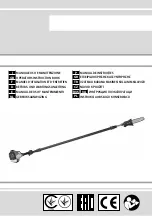
MITER SAW GLOSSARY
ARBOR LOCK –
Allows the user to keep the blade from
rotating while tightening or loosening the arbor locking
bolt during blade replacement or removal.
BASE –
Supports the table, holds accessories and
allows for workbench or leg set mounting.
BEVEL LOCKING HANDLE –
Locks the miter saw at a
desired bevel angle.
BEVEL SCALE –
To measure the bevel angle of the saw
blade 0° to 45° left.
COVER PLATE SCREW –
Loosen this screw and rotate
the plate for access to the blade arbor locking bolt.
EXTENSION WING –
Extends the width of the work
table for support while cutting long work pieces. They
can be used with or without a stop block as an additional
side fence.
FENCE –
Helps to keep the workpiece from moving
when sawing. Scaled to assist with accurate cutting.
HAND HOLD –
Location of hands for transportation.
SAFETY LOCK-OFF BUTTON –
Safety button on
handle must be pushed forward to activate the trigger
switch.
LOWER BLADE GUARD –
Helps protect your hands
from the blade in the raised position, it retracts as the
blade is lowered.
MITER HANDLE –
Used to rotate the saw to the right or
left cutting position.
MITER SCALE –
To measure the miter angle 0° to 45°
left, 0° to 45° right.
MITER SPRING LOCK –
Used in combination with the
miter handle, it locks the miter saw at a preset positive
stop for the desired miter angle.
MOUNTING HOLES –
To mount the miter saw to a
stable surface.
ON/OFF TRIGGER SWITCH –
To prevent the trigger
from being accidentally engaged, a lock-off slide switch
is provided. To start the tool, push the lock-off slide
switch forward and squeeze the trigger. Release the
trigger to stop the miter saw.
STOP LATCH –
Locks the miter saw in the lowered
position for compact storage and transportation.
SWITCH HANDLE –
The cutting head handle contains
the trigger switch and a safety lock-off slide switch. The
blade is lowered into the workpiece by pushing down on
the handle. The saw will return to its upright position
when the handle is released.
WARNING LABELS –
Read and understand for your
own safety. Always make certain these are in place and
legible.
WRENCH STORAGE –
Convenient storage to prevent
misplacing the blade wrench.
WOODWORKING TERMS
ARBOR –
The shaft on which a blade is mounted.
BEVEL CUT –
An angle cut made through the face of
the workpiece.
COMPOUND CUT –
A simultaneous bevel and miter cut.
CROSS CUT –
A cut made across the width or grain of
the workpiece.
FREEHAND –
Performing a cut without using a fence
(guide), hold down or other proper device to prevent the
workpiece from twisting during the cutting operation.
GUM –
A sticky sap from wood products.
HEEL –
Misalignment of the blade.
KERF –
The amount of material removed by blade cut.
MITER CUT –
An angle cut made across the width or
grain of the workpiece.
RESIN –
A sticky sap that has hardened.
REVOLUTIONS PER MINUTE (RPM) –
The number of
turns completed by a spinning object in one minute.
SAW BLADE PATH –
The area of the workpiece or table
top directly in line with the travel of the blade or the part
of the workpiece which will be cut.
SET –
The distance between two saw blade tips, bent
outward in opposite directions to each other. The further
apart the tips are, the greater the set.
WORKPIECE –
The item being cut. The surfaces of a
workpiece are commonly referred to as faces, ends, and
edges.
9
Summary of Contents for M2501LW
Page 25: ...25...
Page 26: ...MOTOR DIAGRAM 26...










































